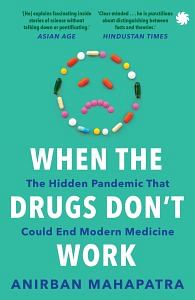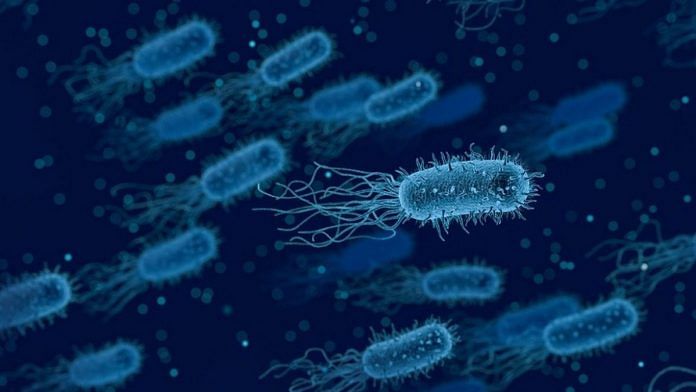In the standard superhero story, an ordinary person is bestowed with superhuman powers after some kind of mishap. I think it helps to imagine superbugs as the microbial equivalent. Antibiotic resistance is essentially the story of ordinary bacteria picking up supergenes that turn them into superbugs. And the more supergenes they acquire, the more sinister they become as fewer antibiotics work against them. It is crucial to understand this to make sense of the problem of antibiotic resistance. We met the Deadly Six superbugs in the previous chapter. It is time to tell you that four of the six are known as ‘Gram-negative’ bacteria.
As we will discuss, these are particularly difficult to beat because they have figured out multiple different ways to thwart the antibiotics we throw at them. What’s worth noting about superbugs is that it’s not the bacteria themselves that are untreatable; it’s their acquisition of multiple supergenes. These confer the resistance that transforms them into invulnerable killers. Broadly, resistant bacteria fall into three different categories of superbugs that sound like they came out of a horrible branding exercise for various models of a car. Bacteria can be tested for their susceptibility. Superbugs are bacteria that are not susceptible to at least a few antibiotics – in other words, they are resistant to these.
MDR bacteria are superbugs that can combat at least one 21 Superbug Signatures antibiotic in three or more categories, rendering multiple treatments ineffective. Next up are extensively drug-resistant (XDR) bacteria which are superbugs whose defences have been honed to the point where they are resistant to all but two antibiotic categories. Most frightening are pan-drug resistant (PDR) bacteria, which are medical nightmares since these are resistant to nearly all or all commercially available antibiotics.
The Deadly Six have elite superbug status because they can pick up many genes that make them resistant to many antibiotics, and they can cause lifethreatening infections. There’s more. Bacteria can grow really fast. They pass on their traits to their offspring in the familiar parent-to-child way like mammals and reptiles. This is how natural antibiotic resistance that arises spontaneously can spread. But here’s the wild part that is entirely different from us: bacteria can also directly share special traits with each other through mobile genetic elements, even if they aren’t parent and child. This is often how they spread those powerful traits that make some of them superbugs.
This process is known as horizontal gene transfer. Mobile elements and horizontal gene transfer play crucial roles in the development of antibiotic resistance and the emergence of superbugs. Bacteria have a single circular chromosome. In addition to the chromosome, they often contain plasmids, which are smaller loops of DNA. These plasmids are significant because they can be easily acquired from other bacteria or the environment, and they can carry genes that provide resistance to antibiotics. Plasmids replicate independently of the bacterial chromosome, and a single bacterial cell can contain numerous copies of a plasmid. Plasmids also often carry antibiotic resistance genes, which weren’t common in plasmids before the widespread use of antibiotics.
Today, plasmids carrying genes that offer protection against various antibiotics have become more prevalent. Often a single plasmid carries multiple antibiotic resistance genes. In such cases, the presence of one antibiotic can help a superbug maintain resistance to several antibiotics since all of the genes are carried on the same plasmid. A daydreaming microbiologist can imagine how this ability might be beneficial to humans. Say, for example, you’re on a bus, and the person sitting next to you has a unique ability – she never catches a cold. What if, just by sitting next to her, you could suddenly gain that same ability? Or imagine that you’re in a classroom sitting next to someone exceptionally good at mathematics. Now, rather than studying for years, what if you could just tap them on the shoulder and instantly gain their ability?
While these analogies help paint a picture, they aren’t perfect comparisons. In our examples, there isn’t a pressing need for you to avoid catching a cold, or to master mathematics overnight. But for bacteria, having antibiotic resistance supergenes can be crucial, especially when someone is taking antibiotics. It might be the difference between the bacteria surviving or dying.
Essentially, the stakes are much higher for the bacteria than in our analogies Horizontal gene transfer is a key reason we have to worry about bacteria sharing supergenes. They can just ‘tap’ into other bacteria and acquire resistance traits, making them even more challenging to combat. Resistance genes that arise in one part of the world can spread in shared environments and make it to different parts of the world. As if things weren’t bad enough, these supergenes aren’t just shared by the same kind of bacteria, they are also shared across different species.
All of a sudden, the E. coli which was harmless in the gut can cause disease and also pick up a mobile snippet of DNA containing a supergene that makes it invincible against antibiotics. This E. coli superbug strain then passes this supergene baton to another disease-causing bacterium like Klebsiella which is in the neighbourhood. Suddenly, you have two different bacteria that have developed resistance, fanning the flames of superbug spread.
 This excerpt from Anirban Mahapatra’s ‘When The Drugs Don’t Work: The Hidden Pandemic That Could End Modern Medicine’ has been published with permission from Juggernaut Books.
This excerpt from Anirban Mahapatra’s ‘When The Drugs Don’t Work: The Hidden Pandemic That Could End Modern Medicine’ has been published with permission from Juggernaut Books.



